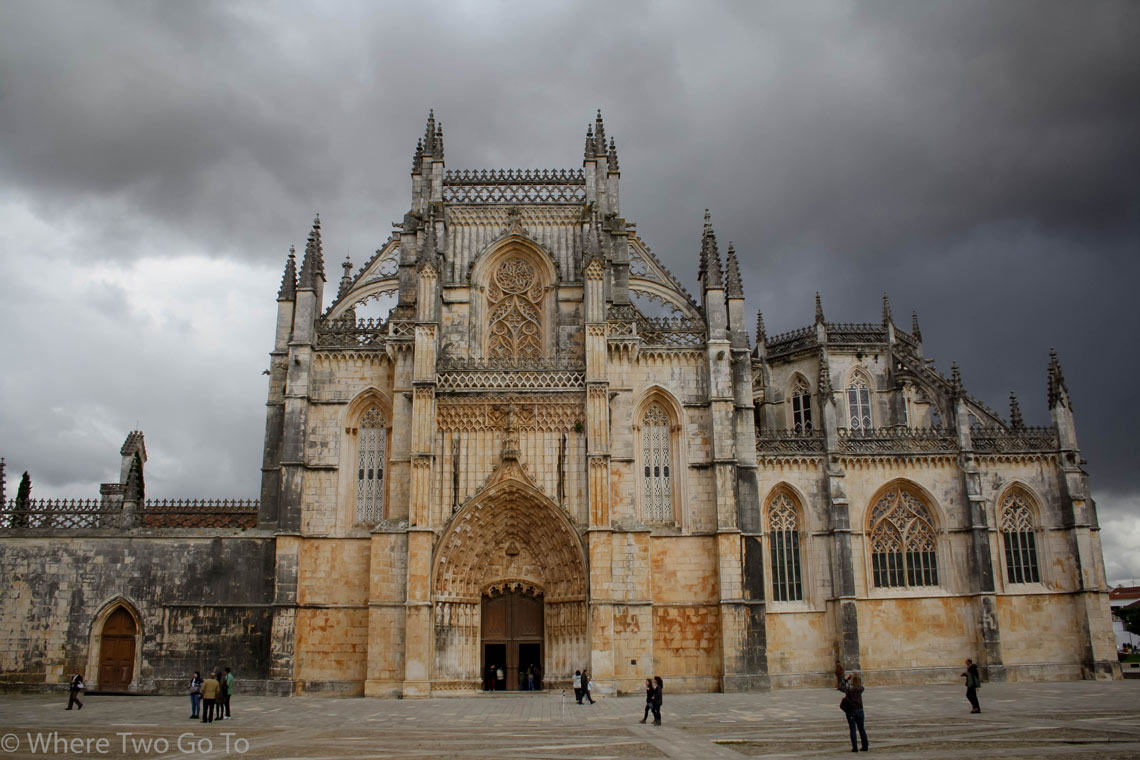The monastery that owes its name to a battle is stupendous. As simple as that. It’s a pleasure for the eyes. A Gothic monument on a Gothic day. The clouds gathered to prepare the introduction of this Portuguese architectural masterpiece. We were amazed and continue to be every time we go visit, even if it’s just for admiring it from the outside.
And now a bit of history…
How can a society turn a great moment in history timeless? By looking at Batalha, we could metaphorically say that it’s by carving that moment.
Batalha is one of those monuments one cannot resist. This 14th century monastery owes its existence, and name, to one of the most critical and greatest moments in Portuguese history, the Battle of Aljubarrota.
On the day of 14 of August of 1385, the Spanish and Portuguese armies clashed on the field called Aljubarrota, near Alcobaça. Juan I of Castile claiming his right for the throne, decided to conquer Portugal by the force of arms. Despite having a smaller army than their invaders, the victory belonged to the Portuguese and their English allies.
The monastery was the promise made by the king of Portugal, John I, to Virgin Mary if victorious.
The construction started immediately after the battle, in 1385/86 and it took more than 150 years, crossing seven different reigns. From the original plans several changes have been made, but its main style is the flamboyant (a late gothic style), mingled with Manueline architecture from the 16th century. All the windows have stained glass, being the first Portuguese building to be chosen for such an artistic solution.
Along the centuries, several vicissitudes had an impact on the monastery, which left noticeable time marks. The three main events were:
1st – The 1755 earthquake
2nd – The French invasions during the Peninsular War (1807-1810)
3rd – The dissolution of the Portuguese monasteries (1834)
The earthquake destroyed several areas, which unfortunately have never been rebuilt, such as the founder’s chapel pinnacle or the forth cloister.
The French invasions are responsible for numerous destructions around the country. Hence, Batalha was no exception. The French troops were responsible for looting and setting fire to the monastery, destroying a third cloister from the mid-16th century.
Probably the worst of all was the lack of protection and maintenance that followed the dissolution of the monasteries in Portugal. After 1834, the monastery was left abandoned and during a long period was used as a school, prison or firefighter barrack.
In 1907, Batalha was declared national monument and in 1983, it became part of UNESCO’s World Heritage.
Nowadays, the entire monument is visitable. These are our favorite areas:
Founder’s Chapel
It is the pantheon of the Aviz family. The tomb of John I and his wife, Filipa of Lancaster, can be found in the middle, as the main attraction. On the side walls one can see several other tombs belonging to their descendants (Henry, the “Navigator” is one of the John I’ sons). Made in gothic flamboyant, it is a beautiful work of stone masonry.
Royal Cloister
This cloister was the first to be built, and was part of the Dominicans daily life. On one of the sides, there is the chapter’s house. After the church, this was the second most important place for the friars, that would serve for discussing the most important aspects of their monastic life.
Nowadays, this chapter’s house is a memorial for the Portuguese Unknown Soldier of WWI. Two soldiers are buried here, one that died in France and another one in Mozambique.
Unfinished Chapels
One can see right away the reason for this name, the ceiling is missing due to lack of funds. Nonetheless, it is here one can feel the true identity of this monument.
Batalha is well worth a visit to praise its grandiosity and learn more about one of the most representative Gothic and Manueline art works in Portugal.
If you want to know more historical details about the battle, go to Centro de Interpretação da Batalha de Aljubarrota.














